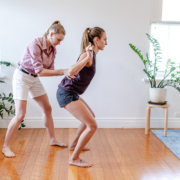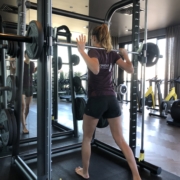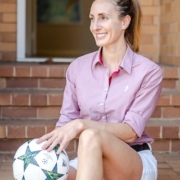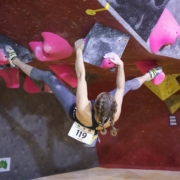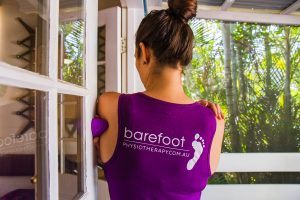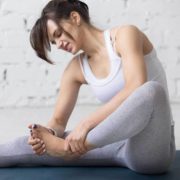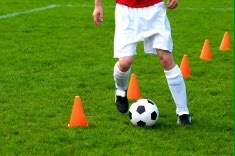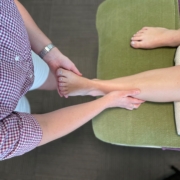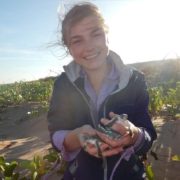Posts
Getting into Exercise
in Barefoot Lifestyle, Physiotherapy ColumnGetting into Exercise
Barefooter Kate Mendel loves her Rock Climbing!
in Barefooter StoriesOur Barefooter Kate Mendel loves her rock climbing.
Self-Releases vs Stretching: When, Why and the Benefits
in Case Study Treatment, Physiotherapy ColumnIf you have been to a Physiotherapist before, there is a good chance you have been prescribed a muscle self-release (Usually performed with a ball) or a muscle stretch of some kind as homework. At Barefoot Physiotherapy, both are prescribed, and for slightly different reasons. Below, we will go through the benefits of Self-Releases vs Stretching and when each are appropriate.
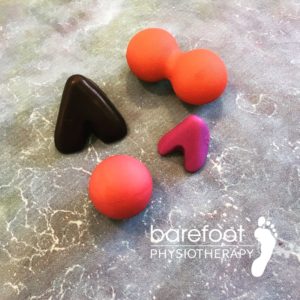 Benefits of both self-releases and stretching:
Benefits of both self-releases and stretching:
- Decrease in tension/discomfort in the muscle
- Potential to lengthen the muscle and increase joint range of motion
- Enhance performance
- Can improve motor control
- Can improve posture
The main prescription differences Self-Releases vs Stretching:
- Nerves have the potential to be irritated with stretching. This is why if a client has any neural irritation, we avoid prescribing stretching until that neural irritation has been cleared. This decreases the chance of aggravating any nerves, and consequently speeds up the client’s recovery.
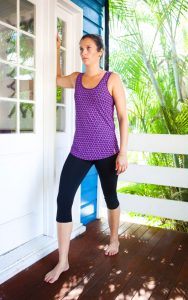 General tight muscles vs. “knots”. A lot of tight muscles have palpable “knots or trigger points” in them. These are in certain areas and not throughout the entire muscle. To target these, muscle releases (With a ball, pocket physio or foam roller) are more effective than stretching the entire muscles. The mechanism of benefit is similar to that of a therapeutic massage, and relies on pressure to the muscle to relieve tension and increase efficiency of the muscle fibres.
General tight muscles vs. “knots”. A lot of tight muscles have palpable “knots or trigger points” in them. These are in certain areas and not throughout the entire muscle. To target these, muscle releases (With a ball, pocket physio or foam roller) are more effective than stretching the entire muscles. The mechanism of benefit is similar to that of a therapeutic massage, and relies on pressure to the muscle to relieve tension and increase efficiency of the muscle fibres.- Stretching on the other hand can be a more effective prescription if the client has an entire muscle group that is notably tight.
- Studies have shown athletic performance benefits when dynamic stretching is used prior to competition.Although there are minimal (if any) studies examining muscle releases immediately prior to athletic performance, we propose that daily muscle releases are also beneficial to performance.
- Performing regular muscle releases can decrease muscle tension and “knots”, and therefore likely benefit athletic performance, similar to stretching.
It is important to understand the benefits and risks of muscle Self-Releases vs Stretching so they can be used safely and effectively. If you have any questions about Self-Releases vs Stretching with your specific exercise program or training regime, ask you physiotherapist or contact us at Barefoot Physiotherapy 🙂
Our friends at Amber Tree Yoga also have a regular release class worth checking out.
Returning to Sport after Injury
in Case Study Treatment, Physiotherapy ColumnHere at Barefoot, a lot of our clients present to us with an injury they sustained during sport. From dance to yoga and football to power-lifting, there is nothing more frustrating than having an injury prevent you from doing the activity you love. The most common question in returning to sport after injury, is how long should I wait? or get treatment for?
Other questions such as:
- How long until I can get back to running?
- How long until I can compete again/re-join my team?
- If I play will I re-injure myself again?
There are some injuries with healing time-frames which dictate roughly the minimum amount of time an athlete will spend in recovery. For example a bone fracture or a complete rupture of a muscle or ligament will have very specific time-frames (and possibly surgical involvement) which will prevent someone from returning to sport within those first couple weeks…
Over the next few paragraphs we’ll discuss sporting injuries, and the approach we take to them at Barefoot Physiotherapy, and how we determine if an athlete is ready to return to their sport.
The most frequent types of injuries we see in clinic are ligament, muscular and tendon soft tissue injuries – of varying degrees.
The steps we take at Barefoot when aiming to get someone returning to sport after injury (After acute management has been given):
- First and foremost – we need the athlete to have no nerve irritation. An athlete with nerve [neural] irritation stemming from the spine will not recover as fast as one who is neural clear. When nerves are irritated (as shown objectively on our Neural Dynamic Tests) the muscles around them tense up and may spasm to protect the nerve. This reduces movement and places higher forces on joints/structures in the body, consequently taking the body longer to recover. If not cleared fully it also predisposes them to further injury. This is a crucial step.

- Appropriate Ranges of Motion (Ideally throughout the entire body – and definitely equal on both sides of the body). By going through the Barefoot Plan, we will determine areas of the body contributing to reduced ranges of motion, and treat those accordingly until an athlete has full range.
- Full Strength and Proprioception about the affected joints – To regain strength and balance, steps 1 and 2 need to have been addressed. The actual strength gains itself will be developed through a therapeutic, sport specific graded exercise program prescribed by one of Barefoot’s Physios or one of the trainers who we commonly refer to.
- By this point in an athletes rehabilitation, pain should be substantially diminishing, if not completely gone.
- Once steps 1-3 have been accomplished, it is now time to think about actually getting this athlete returning to sport. This is done by starting with the most basic principles of their chosen activity, and working our way up to the most complex/challenging aspects of it. To truly be able to determine if someone is ready for returning to sport at 100% intensity, we recreate their sport specific environment, and assess their performance.
- If the client has any pain, discomfort, imbalance or poor motor patterns during the assessment of their abilities…then they are surely not ready to SAFELY return to sport at this time. See below example for returning to sport for a soccer player
For example, assessing a soccer player’s ability to return to sport would involve:
- Running in a straight line – slow pace, no change in speed no change in direction
- Then in a straight line – medium pace, no change in speed no change in direction
- Followed by running in a straight line – fast pace, no change in speed no change in direction
- Then Zig-zag between pylons – slow pace, no change in speed
- Repeat at moderate to fast speeds
- Finally running backwards, then turning and running in the same direction forwards – slow pace
- Repeat at moderate and full speeds
- Soccer ball skills
- Passing a soccer ball short distance (1m) – inside of the foot
- Repeat at moderate and long distances
- All of step 6 above with a top of the foot pass
- Again all of step 6 with right and left foot
- Dribbling the soccer ball
- Slow pace
- Moderate pace
- Fast pace
- All of the above performed in a straight line, and in varying pylon set ups (zig zags)
- Incorporate an unstable environment:
- Steps 1-5 re-performed without the athlete knowing which way they are going to run
- Example: Athlete running at a moderate pace towards Physio, at the last second Physio will point either right or left and the player has to sprint for 3 seconds in that direction
- Steps 1-5 re-performed without the athlete knowing which way they are going to run
- Combination of steps 1-5 with steps 6 and 7
- Incorporating running with ball control
- Example: get the athlete jogging, not knowing when the Physio will pass her the ball, and when it’s passed, having her pass it back immediately with one touch.
- This can be incredibly variable, and will start slow and steady and progress to full speed drills in an unstable environment, where the athlete has to change their speed, change their direction and perform sport specific (soccer ball) skills, all on one drill.
The Assessment
The assessment above is done in such an order (most basic drills to the most challenging) because we want to know immediately if there are any concerns with the athletes’ injury recovery. Unless all of the above can be performed with no concerns, then we would not be happy to tell somebody that they are ready to be returning to sport.
The above example is a fairly basic one. At Barefoot Physiotherapy, returning to sport assessments are tailored to the individual and their specific position and or role in their chosen activity.
Our Job at Barefoot
Athlete safety and recovery is of the utmost importance, and we are here to support you. As part of your support system, it is our job to take you through the above steps, and make sure you are FULLY RECOVERED before we give you our OKAY to return to your chosen activity. There is nothing worse than being told you are recovered, and going out and re-injuring yourself.
If you have any sport specific questions about rehabilitation, please do not hesitate to ask 🙂
Happy sporting!
Fat Ankles from Flying
in Barefoot Lifestyle, Case Study TreatmentDo you suffer Fat Ankles from Flying? With both domestic and international flights back on the cards, more and more of us are flying. Sometimes these trips can be longer than 2 hours, reaching 13 hours for a long-haul flight, which also might be followed by even more flying. Prolonged sitting, lack of movement, dehydration, pressure on the hips and hamstrings can all contribute to fat ankles from flying.
Sometimes no matter how much you try and move around, swollen ankles can still result.
So, why do we get fat ankles from flying, especially on those long trips? Is this dangerous? How do we prevent it?
Let’s start with why this happens. Whenever we are sitting for a long period of time in a plane, the muscles in our legs that are usually responsible for pumping blood and fluid back up are legs are not being used at all. Over time, this will lead to an increase in fluid and blood pooling in our lower limbs (ankles).
Additionally, on long flights in a low air pressure aircraft cabin, it is easy to forget to drink water. Firstly, the stress of flights sometimes makes an alcoholic beverage a more appealing choice, and secondly a lot of people avoid too much water because they do not want to be getting up and going to the toilets on a regular basis while flying. This makes it very easy to become mildly dehydrated on airplanes. Being dehydrated can reduce your blood circulation, making it that much easier for fluid to pool in your ankles on those long flights.
Is this dangerous? The ankle swelling itself is not dangerous, however the reasons which cause it can also cause things like blood clots or deep vein thrombosis (blood clot in your calf), which can be seriously dangerous and has the potential to cause death. So although the ankle swelling itself is not a reason for concern, the reasons which caused the ankle swelling is definitely reason enough to take it seriously and take any necessary precautions to prevent it.
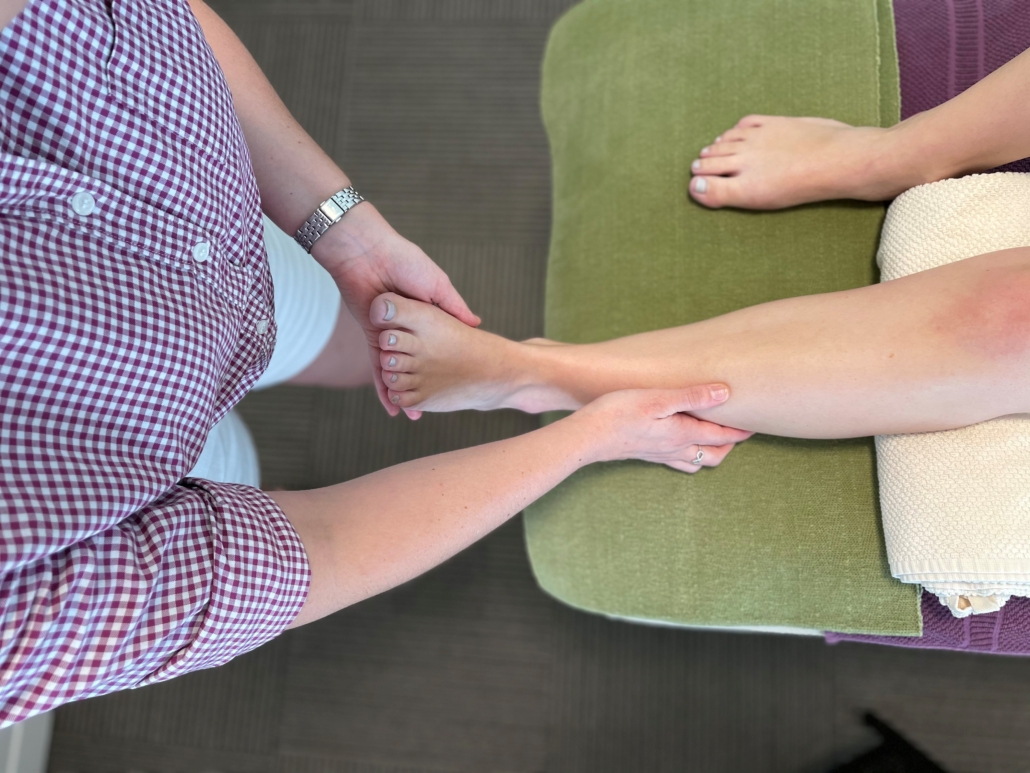
How do we prevent it?
- The biggest thing you can do to prevent poor circulation and subsequent ankle swelling is movement. Aim to get up on a half hourly basis (Assuming you are not asleep) for a walk around the cabin. Aim to be up walking for at least 3-5 minutes each time.
- It is crucial to stay hydrated. This means drinking water before and during the flights. Even if you are having a glass of wine or a beer, try and also have a bottle of water on the go as well.
- It is important to keep your feet and legs moving as much as possible even while you are seated. Pump your ankles from side to side and up and down on a regular basis.
- Some people wear compression stockings while flying to prevent blood clots in their legs. There is evidence suggesting that wearing these stockings can significantly reduce your chance of a blood clot which is great, however it is important to remember that stockings are NOT a substitute for any other of the above precautionary measures, most importantly exercise and frequent movement on a plane.
- There is research that suggests taking aspirin during your flight slightly thins the blood, reducing the chance of deep vein thrombosis and swelling. However, we strongly recommend checking with your doctor before flying if this is right for you.
- Holding or placing your feet above your heart is obviously a great way to keep the blood from pooling in your feet and ankles. If you can, see if you can lift your knees and legs up high, placing them on the seat in front of you – obviously trying not to annoy the passenger in front of you. Handstands in the space outside the toilets or galley is also a fun way to get the blood moving – don’t knock over the food cart!
- After your flight, when you finally get to lie down, put your legs up the wall. This is awesome to drain the legs lymphatic system, encourage oxygenated blood to circulate up the legs and feet.
- Post-flight massage is also a great way to alleviate any swelling. You could do this yourself, or find somewhere close by that you can walk to. The gentle practice of just walking will also assist the body in circulating the blood.
Of course if the swelling doesn’t go down and/or you’re feeling any discomfort or pain, visit a health care practitioner as soon as you can. We’re also here to help, either with some specific treatment before or after you fly. All of our Physios are very well versed in the affects of flying, and are ready to help you make you feel amazing any time you need. Click Here to book online now.
A love for anything health and fitness
in Barefoot Lifestyle, Barefooter StoriesA love for anything health and fitness brought Tristan Forbes into an industry he absolutely loves. Recently starting both Witness the Fitness and Breathing Space, read what brought Tristan on this adventure into keeping people healthy and fit.
What brought you into the health industry in the first place?
As most health professionals, I had a love for anything health and fitness. Mainly sports but I did get into the ‘aesthetic gym scene’ during high-school due to being a rather pudgy kid even with participating in multiple sports at a time since middle school. I’d say my Mum & Dad definitely had an influence as well, Dad competed for Aus in rowing and was a mad-keen triathlete. Mum was into aerobics and workouts at the gym, so looking back at it now, seeing her balance “mumlife” and her health and fitness, would have helped me connect the dots later in life.
You build great communities around you, Witness the Fitness and now Breathing Space – can you describe your passion creating these places for people?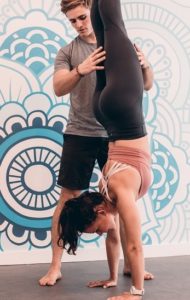
Witness The Fitness was created because we saw how easy it was to transform and help people if they followed a precise plan for 8 weeks. 6 years ago there wasn’t too much out there for anyone and everyone to have access to something like that, to become empowered through education and community/people around them to help change their lives. Because that’s exactly how I did it – I educated myself, surrounded myself with people doing the same thing and over time personal goals were achieved. Some people have had more to transform than others, some people didn’t even need to ‘transform’, a lot of people just wanted to be part of a fun and healthy community. Breathing Space is really an extension of that but more towards the wellness side of things. If you can imagine a scale from fitness (strength, speed, endurance) to wellness (health, balance, longevity), I found that Witness The Fitness really did focus on the fitness side of things – even though we do 10-15 minutes of mobility each session, have an infrared sauna in our gym and preach the importance of sleep and a healthy diet.
With Breathing Space, we can extend our community for one thing, we can shine a light on the importance of yoga and meditation and we can then have this amazing cross over where those who are currently well into their wellness side of things, can get the amazing benefits of introducing a little more ‘fitness’ into their lives and vice versa.
Above all of this.. it’s a passion to help people see and feel the positive side effects of health and fitness. So much so that they want to help their friends and family become healthy and fit. A healthy and fit mother and father is most likely going to one; produce healthy and fit children and two; help those children live healthy and fit lives so that they themselves one day produce healthy and fit children! We aren’t just helping our current members, we are literally helping generations and generations to come!
What drives you and motivates you day to day?
Pretty much everything answered in question one and two.. Ha ha. But also now creating the life I envisioned almost ten years ago now. A successful bunch of businesses that help people, give back to the community and provide my future wife (her name is Matilda by the way, totally envisioned that) myself and our kids our ideal lifestyle. Goals in both personal and business life are forever changing but that really is the one thing that remains day in, day out.
What drew you to open a yoga studio?
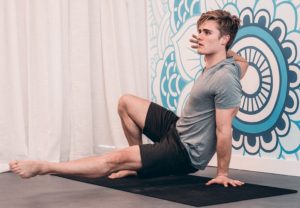 Ever since developing a personal passion for Animal Flow (google it!) two years ago, I have wanted to have a suitable space to run classes, year long intensives and workshops to show people how amazing it really is and how much it can help any athlete, father, mother, anyone! Since learning the importance of energy and vibe in a particular space, I knew that our current Witness The Fitness studio just wasn’t going to work. So when my now Breathing Space business partner, Adam from Nowhere Espresso, mentioned that a yoga studio would go great in the laundromat that was closing down next door.. we hit the ground running and before we knew it – introduced a beautiful space to a quite suburban community in Toowong.
Ever since developing a personal passion for Animal Flow (google it!) two years ago, I have wanted to have a suitable space to run classes, year long intensives and workshops to show people how amazing it really is and how much it can help any athlete, father, mother, anyone! Since learning the importance of energy and vibe in a particular space, I knew that our current Witness The Fitness studio just wasn’t going to work. So when my now Breathing Space business partner, Adam from Nowhere Espresso, mentioned that a yoga studio would go great in the laundromat that was closing down next door.. we hit the ground running and before we knew it – introduced a beautiful space to a quite suburban community in Toowong.
We recently had you at our clinic for an animal flow workshop, explain to people who weren’t able to attend how you got into animal flow?
First, seriously google ‘This Is Animal Flow’.. That’s how I got into it. I watched that video by Mike Fitch, the creator and from there I was hooked. I travelled to the Gold Coast for my first workshop / proper introduction and totally geeked out on the intricate details of how developing animalistic movement abilities improved today’s Homo sapien body.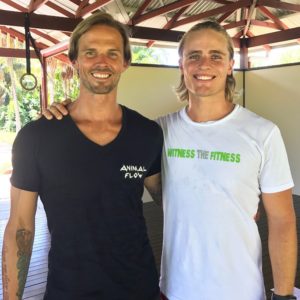
Where to from here? (things you’d like to accomplish next, where you see yourself in 5 years, any new ideas/ambitions)
This year is a big one.. Last month I secured a contract with W Hotel Brisbane where our trainers facilitate the PT sessions for their hotel guests and use their incredible rooftop areas for events, this will help our brand exposure and develop some international relationships for future WTF expansions. In September I am opening a second gym, this one is called FORME Fitness and will have the same health and fitness ethos as WTF but with a deeper focus on 1 on 1 coaching. Very fortunate to get a spot in the new Calile Hotel on James St, cannot wait to see it come to life! Apart from that, build the WTF and Breathing Space community plus ensure everyone is moving forward. Personally; if it were a Saturday or Sunday – watching over a couple of kids, in a house, with a dog or two, chilling after a flow and just be enjoying life really – most likely barefoot too – I like being barefoot.
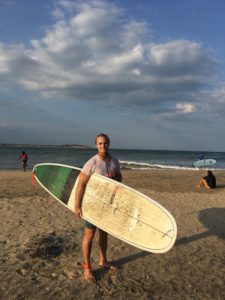
As you know, Tristan recently conducted an Animal Flow workshop here at Barefoot Physiotherapy. Due to its popularity, we’ll probably be holding another workshop later this year.
Don’t forget, you can follow us on both Facebook and Instagram, by clicking through the images below:
Turtle Conservation in Malaysia
in Barefooter StoriesPutting her diving ability to good use while she studies for a Masters Degree in the Environment, Kirsten recently landed her Dream Job studying and caring for Turtles in Malaysia. Turtle Conservation is her passion and her journey is amazing. We’re excited to share her story:
You have just scored your dream job, working in turtle conservation in Malaysia for 8 months. Tell us more about what the job entails and why you are so passionate about this work
I have worked on a few turtle conservation projects in the past, which have involved patrolling the beaches at night for nesting mothers. When you come across one there is often a procedure of measuring, tagging and observing the nest and its parameters which are crucial to understand their mortality rates. The work also involves tracking hatched nests, their success rate and causes of depredation among the eggs.
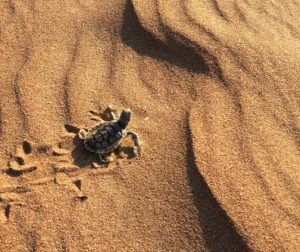
Turtles are the most magnificent animals to work with and I’ve never felt more peaceful than sitting with a mum as she’s laying. Sometimes it isn’t the most glamorous work (scrambled turtle eggs and vultures is not an uncommon combination) and walking anywhere up to 8km throughout the night can be tough but being around these prehistoric creatures make it all worth it in a heartbeat.
The programme I’ll be looking after in Malaysia will cover all these things, where I’ll be working to coordinate volunteers from all over the map. I’ll have some big shoes to fill but having the beach as an office has been my dream for some time!
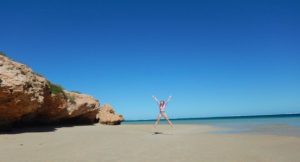 A few projects I’ve worked on have also involved surveying the beaches for poachers. Luckily this isn’t a problem in Australia, however is still a reality in many countries where sea turtles lay their eggs. I fell in love with sea turtles on a project in Costa Rica in 2012 with an amazing crew of local conservationists who were dedicating their lives to protecting them. Only a few months after I came home in 2013 one of my mentors, Jairo Mora Sandoval was brutally murdered by poachers. Its hard to believe, but this is how serious animal trades have become in some parts. I’ve never met someone as passionate for conservation as him, and I promised myself that Jairo’s death would not be in vain.
A few projects I’ve worked on have also involved surveying the beaches for poachers. Luckily this isn’t a problem in Australia, however is still a reality in many countries where sea turtles lay their eggs. I fell in love with sea turtles on a project in Costa Rica in 2012 with an amazing crew of local conservationists who were dedicating their lives to protecting them. Only a few months after I came home in 2013 one of my mentors, Jairo Mora Sandoval was brutally murdered by poachers. Its hard to believe, but this is how serious animal trades have become in some parts. I’ve never met someone as passionate for conservation as him, and I promised myself that Jairo’s death would not be in vain.
One of your big passions in life is scuba diving – tell us what it is you love so much about diving and where are some of your favourite dives?
The feeling I get when I’m underwater is indescribable. It’s one thing to sit on the beach and marvel at the view but knowing what lies beneath makes me appreciate what I’m looking at a whole lot more. I feel so lucky to live in a world where such exquisite life exists. And even better is how us humans have worked out how to breathe underwater!
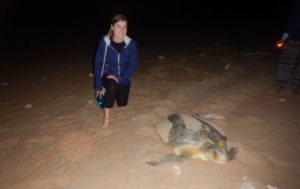
Every dive is different, but my most memorable ones have been throughout Central America. I dived in a cenoté in Mexico which is an underwater limestone cave that you enter through a hole that may only be a few metres wide but would open up to a range of huge caverns underneath. It was extremely challenging both mentally and physically, knowing that you had to conserve enough air to be able to follow a line throughout the cavern. At one point we surfaced into ’The Bat Cave’, which as the name suggests, was full of bats hanging from the stalactites (those formations that hang eerily from the roof). I don’t know if I’d do that bit again!
Nothing compares to exploring your own backyard and diving over at Stradbroke Island during Grey Nurse Shark season is truly amazing. They are gentle sharks who nurse their young in the waters off Straddie, and I’ve been lucky enough to see a manta rays, turtles, nudibranchs and so much more on the same dive!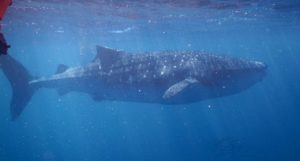

Acknowledgement of Country
Barefoot Physiotherapy proudly operates on Jagera and Turrbul land. We acknowledge Traditional Owners of Country throughout Australia and recognise the continuing connection to lands, waters and communities.
We pay our respect to their Elders past and present and extend that respect to all Aboriginal and Torres Strait Islander peoples today.

